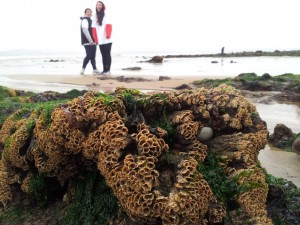THE largest reported honeycomb
reef in Europe may well
have been located in the Waterford
Estuary, which would establish
the area between Waterford
and Wexford as a priority habitat.
Coastwatch Ireland is currently
working hard to establish
if this honeycomb reef is the
biggest reported reef of its kind
in Europe; a near Saint-Malo
in Brittany currently holds the
record.
“This is a tremendous discovery,”
said marine biologist Karin
Dubsky, who is co-ordinating the
project on behalf of Coastwatch
Ireland. “But we need more surveyors
and divers to see if we
can verifying the scale of the fi nd
we believe we have made, which
is a source of great excitement to
people in my line of work.”
Ms Dubksy explained: “Honeycomb
reef is created by a small
worm
called sabellaria albeolata
which lives inside small tubes
that it builds from sand and shell
– quite why we do not know. But
when thousands of these worms
work together they can form
massive reefs along the coastline
and form useful habitat for other
marine life – in essence they are
the bioengineers of the sea!”
As part of the 2015 Biodiversity
Week, Coastwatch invited
the public to walk the shore
at low tide to check for reef
outcrops and help measure the
length and size of the reef, with
kayakers and divers also taking
part in the study, as he worms
continue building into shallow
water.
On Monday last, May 18th,
the fi rst set of ‘Coastwatchers’
started checking the shore
simultaneously around low tide
on either side of the Estuary,
between the Hook and Duncannon
in Wexford, and between
Annestown and Brownstown
Head in Waterford.
“From the air, a member of
the Waterford Aero Club told us
it looked liked sprinkled cheese;
so we appear to be on the brink
of making a great fi nd,” said Ms
Dubsky.
On the Wexford side, Emmet
Delaney found a healthy honeycomb
reef measuring between 10
and 55 metres wide, straddling
low water having walked two
500-metre survey units from
Booley Bay towards Duncannon
without reaching the reef’s end.
On the Port Láirge side, Alan
Walshe led a training event at
Tramore Lady’s slip, while pupils
from Our Lady of Mercy School
and other surveyors found reef
patches “like big hedgehogs”
attached to the bedrock over a
250 square metre area.
“And we’ve already had ‘reef
tourists’ in the area, after students
from a German University
decided to add a trip to the
Estuary to their itinerary after
travelling from Connemara,”
said an enthused Ms Dubsky.
A story more factual than
fi shy, this discovery could be of
enormous scientifi c signifi cance
for the Estuary, and no doubt
we’ll have more on this in future
editions.


